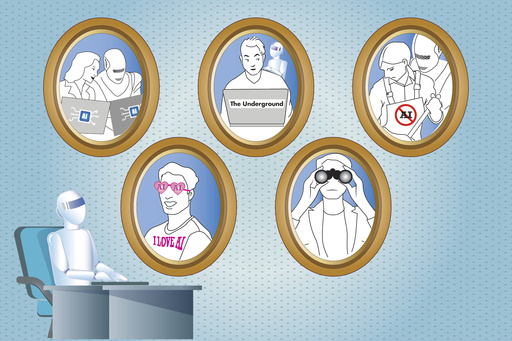
SAN FRANCISCO – The growing prominence of artificial intelligence (AI) in professional settings has left numerous employees pondering how frequently they should integrate this technology into their daily tasks and whether it poses a threat to their job security.
This revelation stems from a comprehensive survey by workplace communication platform Slack, which interviewed 5,000 office workers. The study identified five distinct AI user profiles in the workplace: “The Maximalist,” who frequently employs AI tools; “The Underground,” who uses AI discreetly; “The Rebel,” who actively opposes AI; “The Superfan,” enthusiastic yet inexperienced with AI; and “The Observer,” who is tentatively monitoring the situation.
Interestingly, only half of the surveyed individuals identified as Maximalist or Underground, indicating a significant challenge for companies hoping to cultivate a culture that embraces AI. Recently, insights around the mixed feelings towards AI in the workplace were shared by Slack’s senior vice president for research and analytics.
In discussing the varied perceptions of AI, it was noted that these disparate experiences invoke different emotional responses. For many, feelings of apprehension or guilt may hinder their willingness to interact with AI technologies. It’s crucial to address these emotions to boost AI usage and foster an environment where employees can value this emerging technology.
Maximalists demonstrate a complete commitment to AI, reaping benefits from its usage and actively promoting their experiences. Conversely, The Underground utilize AI secretly, often out of fear of being perceived as incompetent or accused of dishonesty. This reveals a significant opportunity for organizations to implement clear guidelines that empower employees to confidently use AI without fear of negative connotations. Currently, many feel unsure and unsupported in their AI engagements.
Despite the challenges, there remains a broader enthusiasm for AI among workers, which presents an exciting prospect for businesses looking to leverage this momentum.
Additionally, the study revealed that approximately 19% of participants fell under the “Rebel” category. Notably, this group tends to be predominantly female, with older individuals showing heightened resistance. It indicates a gap in technology adoption rates, with men generally embracing AI more readily than women.
Women may perceive AI as a threat to their job security, often feeling less trusted in the workplace compared to their male counterparts. This lack of trust may inhibit their willingness to experiment with AI, whereas men might feel more secure in their roles, leading them to engage with the technology more freely.
To facilitate a smoother integration of AI into workplaces, companies should address a few key areas. First and foremost, many desk workers report a lack of clear directives regarding AI use, presenting a significant opportunity for organizations to communicate expectations effectively.
Creating a celebration of AI within workplace culture can also encourage acceptance. By showcasing examples of responsible AI use and success stories, organizations can motivate employees to engage with the technology.
Lastly, fostering an environment of experimentation will allow employees to comfortably test AI methods, easing any hesitations they may have. Small tasks such as using AI to draft emails or summarize documents can serve as a valuable entry point for employees to become familiar with the technology’s advantages.
Regarding concerns around job displacement due to AI, there is a prevailing belief that those who successfully integrate AI into their work will have a competitive advantage over those who do not. This points to a future landscape where proficiency with AI may become essential in retaining job security.
